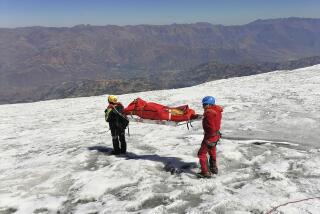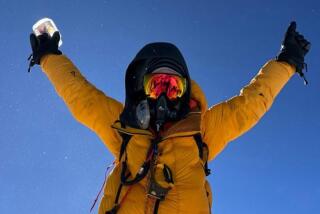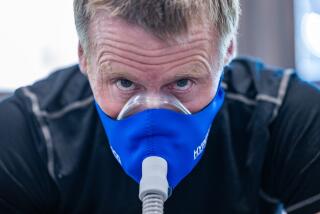Near-death experience
When Nicholas Rice awoke just before midnight July 31, he was confident that the next day he would stand on the summit of K2, the world’s second-highest mountain and the most challenging to climb.
The forecast was for good weather, and after some earlier health issues, Rice was feeling strong. The 23-year-old climber from Hermosa Beach planned to climb K2 as he had other Himalayan peaks, alone and without supplemental oxygen.
In his tent at Camp 4, a staging ground for summit attempts located 8,000 meters up the mountain in the so-called “death zone,” he began the tedious job of melting snow on a small stove. He knew it would take more than an hour to melt the two liters he would need for his climb, but just as he had finished melting the first panful of water, he spilled it, soaking his socks and delaying his start for two hours.
The delay probably saved his life.
That afternoon, 11 climbers who started for the K2 summit ahead of Rice died on the mountain in one of the deadliest days in mountaineering history.
Rice had hoped to begin his push for the summit about 2 a.m. But because of the spill he did not leave his tent until nearly 4:30. An hour into the climb, he began to worry about frostbite.
“I knew in the back of my mind that I might not have enough time to summit because I was starting so late,” he said in an interview from K2 base camp in Pakistan on Wednesday. “Then, when my hands just wouldn’t warm up, I decided to turn back and try again the next day. . . . K2 is already the hardest mountain to climb in the world. You don’t need any added difficulties.”
Back at Camp 4, as he and other climbers were talking, an Italian watching the peak shouted “accident!” and gestured toward a steep section of the mountain known as the Bottleneck. Someone had fallen from the ropes, and it appeared that another climber was attempting to help.
Rice and the others began planning a rescue, radioing to camps lower on the mountain where climbers wouldn’t be as debilitated as those already in the death zone, where much thinner air quickly depletes muscle strength, stamina and mental functioning.
But they soon learned over the radio that the man who fell, a Serbian, as well as a porter who had tried to rescue him, were dead. At that point, Rice decided to head down the mountain.
“Someone had just died on the route I was attempting to climb,” he said. “Clearly the ropes weren’t fixed correctly, and I wasn’t going to risk that.”
After a night at 3,000 meters, Rice and another climber continued down toward base camp on Saturday morning. When they stopped lower down to melt water and rest, Rice turned on his satellite phone and received a disturbing text message from his mother.
After he had left Camp 4, a massive sheet of ice near the K2 summit had fallen, causing an avalanche that killed some climbers and left others stranded high on the mountain.
Rice shared an expedition permit with seven other climbers -- four from France, one from Germany and two from Pakistan.
In nearly two months on the mountain getting acclimatized and carrying supplies to higher and higher camps, Rice had grown closest to French climber Hugues d’Aubarede, a 61-year-old grandfather who was making his third K2 attempt.
D’Aubarede had left camp more than two hours before Rice on Friday morning, and he probably would have been near the summit when the ice fell.
But Rice couldn’t think about that possibility. He was exhausted and dehydrated, and he still had to make a tough descent.
“I knew I had to get down to base camp before I could allow myself to worry,” he said.
When he finally got there, he learned that d’Aubarede had reached the summit, but that he had been stranded above the avalanche. While he still hoped for the best, Rice knew that his friend’s survival was unlikely.
“A night outside above 8,000 meters is almost always deadly,” he said.
Climbers at base camp were “huddled around a telescope, trying to see the upper mountain,” Rice said, but it took time for reliable information to trickle in. When it finally did, Rice learned that d’Aubarede was dead, along with the two high-altitude porters who had climbed with him.
In the days leading up to the summit attempt, Rice and d’Aubarede had given each other the phone numbers of their closest family members.
“You come here knowing there is a real possibility that you’re going to die on the mountain,” Rice said. “Hugues said he wanted me to be the one to tell his family if something horrible happened.”
The calls weren’t easy, Rice said, but he fulfilled his obligation, knowing how much his own family would have appreciated such a gesture if the situation had been reversed.
Rice grew up in Hermosa Beach, the son of two engineers who loved the outdoors.
“Before we could even walk, our parents were taking us up Mt. Shasta in a backpack,” said Rice’s sister Rebecca. “They encouraged us to love nature, and he took it to another level.”
In high school, Rice started serious rock-climbing and then moved on to mountains, climbing Mt. Shasta, Mt. Rainier and Mt. McKinley before attempting his first Himalayan peak, Cho Oyo, in 2004. Since then he has climbed in the Himalayas each summer.
Rebecca Rice said she and her parents keep up with Rice’s progress in occasional phone calls and through the blog he maintains and try not to worry. She said they’re confident that he doesn’t take unnecessary risks.
On K2, she said, he called home from high up on the mountain to discuss his decision to abandon a summit attempt.
“I’m really proud of him,” she said. “I know that making it up the mountain would have gotten him a lot of attention and maybe sponsorship and other things. But I’m glad he wasn’t just focused solely on that and knew enough to turn around. If he’d kept going . . . he might not have been able to get down.”
Rice said he plans to return to K2 for another attempt one day.
“I’ll come back with a lot more knowledge of what to expect,” he said.
Meanwhile, he hopes to climb in the Himalayas again next summer, he said. “But maybe I’ll do something easier, like Mt. Everest.”
--
--
On latimes.com
To see additional photos from Nicholas Rice’s expedition to K2, go to latimes.com/k2.



